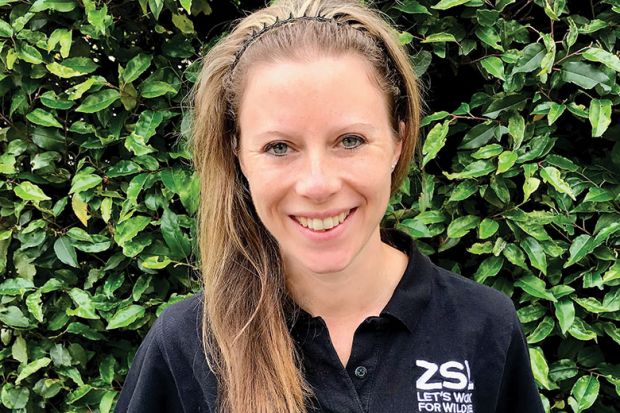Interview with Tammy Shadbolt
 Tammy Shadbolt is a wildlife veterinarian and research associate working on the Disease Risk Analysis Health Surveillance for Interventions project at ZSL (Zoological Society of London), a collaborative initiative with Natural England that monitors the risk of disease during conservation work. A veterinarian for more than a decade, she teaches and researches pathological investigations and was previously a tutor at the Royal Veterinary College.
Tammy Shadbolt is a wildlife veterinarian and research associate working on the Disease Risk Analysis Health Surveillance for Interventions project at ZSL (Zoological Society of London), a collaborative initiative with Natural England that monitors the risk of disease during conservation work. A veterinarian for more than a decade, she teaches and researches pathological investigations and was previously a tutor at the Royal Veterinary College.
Where were you born?
In Sussex, in a little village in the South Downs.
How has this shaped you?
I spent a lot of time outdoors in the countryside as a child. I wanted to care for the animals and plants. When I was five, I began “rescuing” woodlice and even took to carrying water from home into the woods in old yoghurt pots to water particular plants I felt needed hydration.
How did you choose your career?
When I was 16, I did work experience at a veterinary practice and at an environmental organisation and loved both, not realising that I would eventually combine careers in them. After working as a vet around the world, volunteering on conservation projects, gaining further training in veterinary conservation medicine, wild animal health, non-governmental organisation management, veterinary education and doctoral research, I finally found a way to bring everything together.
What kind of student were you?
Very studious at school and a little crazy at university. I passed, failed and bounced back determined. I believe your student days are an opportunity to embrace highs and lows and explore the opportunities open to you, both academic and non-academic.
How did you get your current job?
I moved to London eight years ago specifically to study for the master’s degree in wild animal health at ZSL. I subsequently began facilitating on the postgraduate programmes here while developing my academic teaching and research portfolio and my veterinary practice work. As with any specialist role, the jobs are relatively few and far between. Keeping the hope, pursuing different avenues and developing positive contacts eventually led me to be in the right place at the right time.
What’s your favourite part of your job?
I love the diversity; no two days are the same. I am involved with different projects and people who are working to save endangered British species, including mammals, birds, reptiles, amphibians and invertebrates. My role involves advising on how to keep animals healthy during a conservation intervention, such as a reintroduction. One day I might be accompanying butterflies on a journey to ensure that they remain well during a translocation, the next conducting a post-mortem examination on a red kite, looking for clues as to whether it has been shot, poisoned or died from infectious disease. I also enjoy carrying out my research, writing reports and teaching students.
What’s the worst part?
I have quite acute senses, and I often wish I didn’t. Carrying out post-mortem examinations on maggot-riddled, rotting wildlife carcasses is far from pleasant, and the smell seems to saturate hair, skin and clothes for the rest of the day.
Is it hard to balance the practical and the academic elements of your job?
Spring and summer are certainly a juggle. This is the time when I am most likely to be out in the field assisting on translocations or carrying out post-release health surveillance, but there are still reports to be written, research projects to be undertaken and meetings to attend back at base. I care about all of the individual animals that I work with, but the role equally requires me to think about complex issues facing threatened populations and whole ecosystems. The opportunity to play a tiny part in the big conservation challenges facing our planet feels like a huge responsibility and an enormous privilege.
What’s the most common misconception you face working as an academic in a zoo?
People often have quite strong opinions about zoos, which is understandable based on the centuries of not understanding animal health and welfare. Today, zoo animals are born in captivity and the time, care and science that goes in to keeping them happy and healthy is phenomenal. Zoos have a huge role to play in educating the next generation about all creatures and the need for conservation.
What advice would you give to prospective students in your field?
There could not be a more pertinent time to consider a career in conservation. The world is waking up to the devastating effect humans are having on the planet, but we have a long way to go before we realise how to mitigate, manage and mend the damage done and live sustainably in the future.
What advice would you give to your younger self?
Believe in yourself and the direction you’re travelling in. A mentor once said to me that at each fork in the road, the logistics have a way of working themselves out once you know what you really want to do.
What do you do for fun?
I am a dancer in my spare time and take classes all over London. Finding an expressive outlet and embracing your creativity is really important to achieving a balanced sense of well-being in life.
What would you like to be remembered for?
For inspiring others. One of my most precious memories is of watching my first vet student tutees stand up, take their veterinary oath and graduate into the profession after five years of hard work. It was an overwhelming and wonderful feeling to have played even a small part in helping them realise their dreams.



